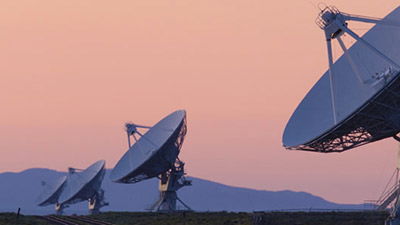Is ET Calling Us?
SETI experiment suggests non-natural radio signal coming from the vicinity of Proxima Centauri, but seems to be another failed attempt to find alien life
On December 18, 2020, the UK’s Guardian newspaper leaked news that a SETI (Search for Extra-Terrestrial Intelligence) experiment had detected a possible non-natural radio signal coming from the vicinity of Proxima Centauri, the closest star to earth. Breakthrough Listen, a SETI program in operation since January 2016, piggybacks on existing programs of radio telescopes at the Green Bank Observatory in West Virginia and the Parkes Observatory in Australia. In the spring of 2019, the Parkes telescope observed Proxima Centauri over many 30-minute intervals looking for flares from the star. The purpose was to ascertain what effect flares might have on Proxima Centauri b, a planet closely orbiting the star that is a candidate for being earthlike. The collected Breakthrough Listen data was not analyzed until a year later. During some of the 30-minute observations taken in 2017, a signal at 980 Megahertz (MHz) was detected. A slight Doppler shift in the signal was consistent with Doppler motion of Proxima Centauri b as it orbited the star. This raised the possibility that the 980 MHz signal came from an advanced civilization on that planet. This signal has been named BLC1, for Breakthrough Listen Candidate 1.
Digging Deeper
What other possibilities might there be to explain BLC1?
But, as Carl Sagan frequently said, extraordinary claims require extraordinary evidence. As much as the most ardent evolutionary scientists would be delighted to discover alien radio transmissions, they are cautious. This caution is well advised because there have been false positives of alien transmissions before. What other possibilities might there be to explain BLC1? This signal could have been from a manmade source. There are no spacecrafts that broadcast at 980 MHz. However, there are terrestrial systems that use that frequency. The question is, could these systems cause interference in the Parkes Radio Telescope?
The 2019 observations required background observations for reference to calibrate the measurements. This was done by alternating the 30-minute scans of Proxima Centauri with 30-minute scans when the Parkes radio telescope was not pointing directly at Proxima Centauri. The 980 MHz signal was not present in these background scans, which is a factor in favor of this signal coming from Proxima Centauri. On the other hand, the 980 MHz signal was not always present in the direct scans. Furthermore, once astronomers became aware of the 980 MHz signal, they repeated observations of Proxima Centauri but failed to detect the signal again. If the 980 MHz signal is a broadcast from an intelligent agent, why was it so intermittent? Finally, there was no modulation in either frequency or amplitude that would encode information as manmade radio broadcasts do. A signal with no information is hardly evidence of an extraterrestrial intelligent source.
As tantalizing as this signal may be, it is very unlikely to be anything more than a one-off.
There are still many questions about BLC1. It doesn’t appear to be just noise in the data. Could it be interference from some terrestrial source? Even if the signal were from a source outside the solar system, was it necessarily coming from Proxima Centauri? The signal could have originated from another object in the same direction of Proxima Centauri. Finally, could this signal have been from a natural source that we have not yet anticipated? For instance, could there be a plasma effect that intermittently radiates at 980 MHz as the planet Proxima Centauri b orbits its star? As tantalizing as this signal may be, it is very unlikely to be anything more than a one-off. In time, a natural explanation likely will be found.
Conclusion
As hinted earlier, evolutionists generally expect that life, even intelligent life, is common in the universe. The best way to confirm this expectation is detection of alien radio transmissions. After all, it is generally realized that since man has been broadcasting radio for a century, alien civilizations within 100 light years of the earth ought to be able to intercept our radio transmissions and hence become aware of our existence. This is the reason for the keen interest in SETI, for it amounts to a test for the naturalistic origin of life. The failure of extensive SETI searches over more than a half century amount to the failure of this evolutionary prediction. On the other hand, creationists generally think that intelligent life, human-like beings, is unique to the earth. Therefore, we predict that we will never discover radio broadcasts from other worlds. The many SETI experiments confirm this prediction. Some creationists oppose funding SETI projects, calling them a waste of time. However, these experiments test the contrasting predictions of evolutionists and creationists. Therefore, of all people, creationists ought to welcome SETI projects, especially when they are not funded by taxpayer money (as is the case with Breakthrough Listen).
Recommended Resources

Answers in Genesis is an apologetics ministry, dedicated to helping Christians defend their faith and proclaim the good news of Jesus Christ.
- Customer Service 800.778.3390
- © 2024 Answers in Genesis








